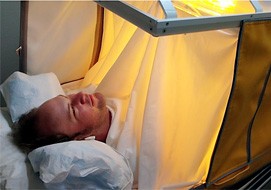UA researchers are using heat to treat depression.
The ongoing study, led by UA psychiatry professor Charles Raison, is examining the effectiveness of a technique known as whole-body hyperthermia as a treatment for depression. Early results show that the technique works, Raison said.
“This is one of the first studies of depression treatment that is not directly targeting the brain itself,” said Clemens Janssen, one of Raison’s graduate students at the UA’s John and Doris Norton School of Family and Consumer Sciences.
Raison’s interest in the link between body temperature and mood was inspired by Tummo meditation techniques, used by Tibetan Buddhists to reach a euphoric state by increasing their body temperature.
However, this study is the first time that the technique is being experimentally tested, he added.
“We’ve tapped into something that is an ancient human practice,” Raison said.
Many other indigenous cultures have used hyperthermia as a means of healing and spiritual advancement, said Tommy K. Begay, a research associate in the UA Department of Psychiatry and the John and Doris Norton School of Family and Consumer Sciences. Begay studies how Native American spiritual practices affect health.
According to Raison, the chemicals that are important for regulating body temperature are also important for regulating mood.
His lab uses infrared heating to elevate the participant’s core body temperature for two-to three-hour-long sessions. Interviews and questionnaires administered before and after the treatment were used to determine the procedure’s effectiveness at improving depression symptoms.
Medications, such as selective serotonin reuptake inhibitors (SSRIs) are commonly used to treat depression but do not work for everyone and can often lead to side effects such as nausea, dizziness and drowsiness, Raison said.
“What I see as a real benefit of our work to the community and those who suffer from depression is that this offers an alternative to drug therapy,” said Kim Kelly, the study’s research coordinator and a graduate student studying medical anthropology.
However, depression is more than just a brain disorder. Raison said it results from complex interactions between many different levels of reality, ranging from the body to ecosystem-wide disturbances that are common in the modern world.
The study makes use of this concept in exploring how the peripheral sensory pathways can be used to stimulate specific areas of the brain.
“When this pathway is activated, the brain cheers up,” Raison said.
According to Raison, once complete, the study will be used to determine if whole-body hyperthermia is a viable treatment for depression.









